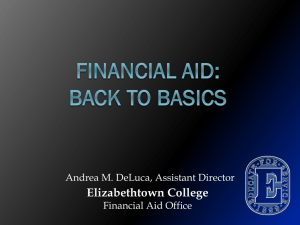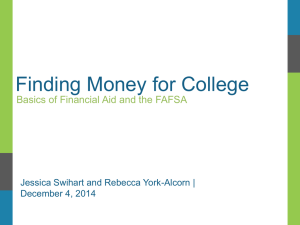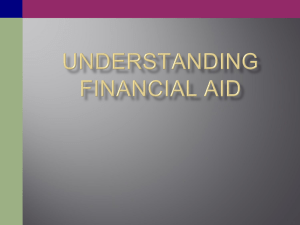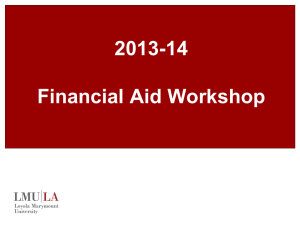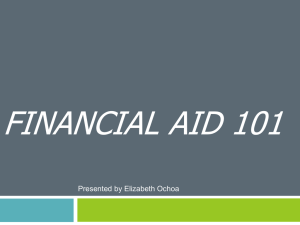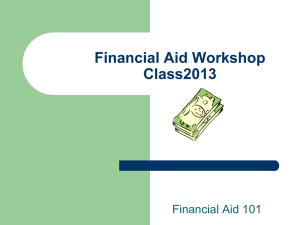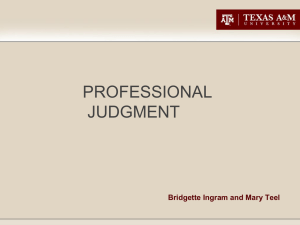Community Financial Aid Night PowerPoint
advertisement
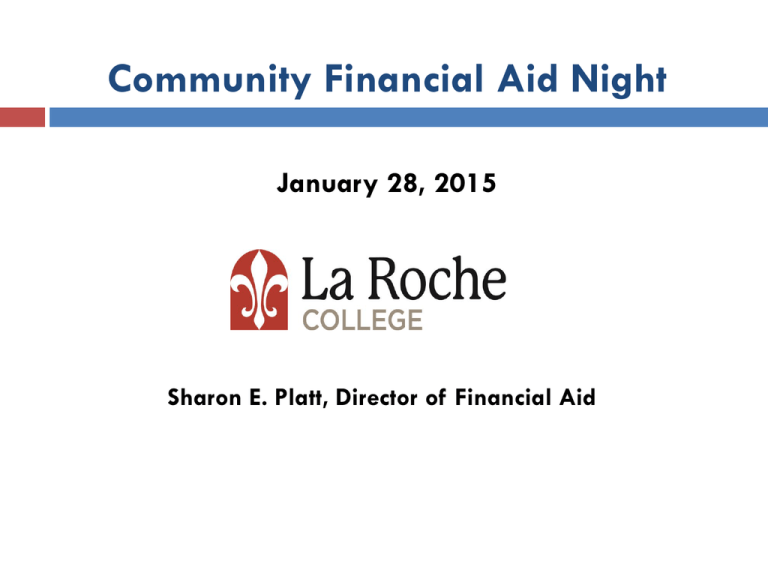
Community Financial Aid Night January 28, 2015 Sharon E. Platt, Director of Financial Aid Topics We Will Discuss Tonight What is Financial Aid? Types Of Financial Aid How To Apply For Financial Aid Cost of Attendance (COA) Expected Family Contribution (EFC) Financial Need What Happens Next? FAFSA On-The-Web Demo What is Financial Aid? Financial Aid is funds provided to students and their families to help pay for postsecondary educational expenses in the form of: Grants Scholarships Loans Employment Gift Aid vs. Self-Help Aid GIFT AID Grants/Scholarships - Gift money that does not have to be paid back SELF-HELP AID Loans - Borrowed money that has to be paid back over a period of time, often after the student completes their degree Work-study - money students earn by working at a part-time job Categories of Financial Aid Merit-Based Aid Aid given to students strictly on the basis of merit. May be based on: Academic record Special characteristics Skills or talents Involvement Does not have to be repaid Usually renewable from year to year Need-Based Aid Aid awarded to students on the basis of financial need. Re-evaluated each year as financial situations may change. Sources of Aid Federal government State The College/University Outside Organizations/Employers Federal Aid Largest source of financial aid Aid awarded primarily on the basis of financial need Must apply each year using the Free Application for Federal Student Aid (FAFSA) Common Federal Aid Programs Federal Pell Grant Federal Supplemental Educational Opportunity Grant (SEOG) Teacher Education Assistance for College and Higher Education Grant (TEACH) Federal Perkins Loan Federal Work-Study Federal Subsidized and Unsubsidized Loans Federal PLUS Loans State Aid Residency requirements Use information from the FAFSA Deadlines vary by state PHEAA Deadline is May 1 College/University Aid Factors that may influence institutional aid: Academics Athletic Ability* SAT’s/ACT’s AP Courses Legacy (child of alumni) Activities Talent Gender/Ethnicity Class Rank Financial Need *Athletic awards offered by NCAA Division I and Division II schools only. Outside Organizations Foundations, businesses, charitable organizations Deadlines and application procedures vary Begin researching private aid sources early To what organizations and churches does student and family belong? Application process usually spring of senior year Small scholarships add up! Check company where parent is employed HOW TO APPLY FOR APPLYING FOR AID What Is The FAFSA? FAFSA = Free Application for Federal Student Aid Application for federal and state aid (may be application for college aid as well, depending upon the school) File one FAFSA per year, per student (not one per college) List up to ten colleges - Title IV Code or school name; schools receive information electronically How/When to File the FAFSA? FAFSA’s are completed online: www.fafsa.gov Register for a PIN #: www.pin.ed.gov Complete as soon as possible after January 1 and before the school’s deadline PA residents must file by May 1 for state grant consideration for following fall term May use estimated income and taxes or prior year tax forms Don’t wait to be accepted to college to complete Cost of Attendance Direct Costs Tuition Fees Room Board Indirect Costs Books and Supplies Transportation Personal Living Expenses Child care and special equipment purchases may be considered Expected Family Contribution (EFC) Number used to determine student’s eligibility for financial aid EFC is the amount the family can expect to pay toward college expenses each year It is rarely the amount the family actually pays Number is a result of federal formula based upon information supplied on FAFSA Income (taxable & nontaxable) Taxes paid Assets Household size Number in college What is financial need? Cost of Attendance - Expected Family Contribution __________________________________ = Financial Need Examples of Financial Need $35,000 $30,000 $25,000 $20,000 COST NEED EFC $15,000 $10,000 $5,000 $0 School 1 School 2 School 3 Net Price Calculator Every school is required to have one on their website CAUTION: Some are better than others Get estimated EFC at: www.fafsa.gov and use FAFSA4caster FAFSA on the Web’s Homepage What happens after FAFSA is filed? Verification 35% of all students are randomly selected for verification The school will notify you to submit additional documentation School may give you an ESTIMATED award letter YOU MUST SUBMIT ALL REQUESTED INFORMATION BEFORE FINAL AWARDS ARE GIVEN What Happens Next? Aid eligibility is determined by school Receive financial aid award letter from each college/university Deposit usually) at college of choice (non-refundable Comparing Aid Offers • Don’t assume that more expensive schools will necessarily cost you more! • Look at same “bottom line” for each school. Compare “apples” to “apples.” • What is amount of loan in package vs. amount of grant? • What is amount of work study? • Are grants/scholarships automatically renewable? • Is there room for movement? • Check with the Financial Aid Office—there might be but it’s not “Let’s Make A Deal!” Need More Financial Assistance? Payment Plan Parent PLUS Loan Alternative Loans FAFSA On-the Web Demo What You Need Before Filing FAFSA Student’s and parents’ social security number or alien registration or permanent resident card (if not a U.S. Citizen) Student & Parent 2014 W-2 forms and other records of money earned Student & Parent 2014 Federal Income Tax Return (1040, 1040A or 1040EZ) Student & Parent 2014 untaxed income records (veterans benefits, child support received, workers compensation) Student & Parent current bank statements Student & Parent current business and investment mortgage information, business and farm records, stock, bond, and other investment records Student drivers license Depending on parent’s marital status, date of parent’s marriage/separation/remarriage Special Circumstances Experience significant decrease in current calendar year income 2015-16 FAFSA based on 2014 income Cannot report on FAFSA Change in employment status Medical expenses not covered by insurance Change in parent marital status Unusual dependent care expenses Contact Financial Aid Office at each college Don’t Forget! Research Outside Scholarships (www.fastweb.com) Complete the FAFSA form as soon as possible after January 1 of senior year Keep copies and sign every financial aid form that you complete! Check with each college/university to see what additional forms they require Don’t be afraid to call the financial aid office at the schools you are interested in and ask questions if you don’t understand Remember deadlines – APPLY EARLY! Any Questions? Thank you for coming!
